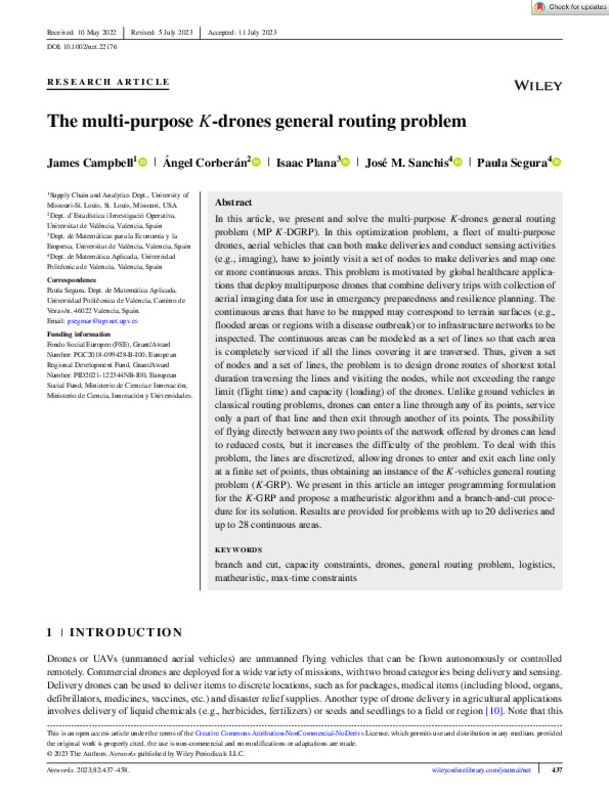JavaScript is disabled for your browser. Some features of this site may not work without it.
Buscar en RiuNet
Listar
Mi cuenta
Estadísticas
Ayuda RiuNet
Admin. UPV
The multi-purpose K-drones general routing problem
Mostrar el registro sencillo del ítem
Ficheros en el ítem
| dc.contributor.author | Campbell, James
|
es_ES |
| dc.contributor.author | Corberán, Ángel
|
es_ES |
| dc.contributor.author | Plana, Isaac
|
es_ES |
| dc.contributor.author | Sanchís Llopis, José María
|
es_ES |
| dc.contributor.author | Segura-Martínez, Paula
|
es_ES |
| dc.date.accessioned | 2024-04-11T06:28:21Z | |
| dc.date.available | 2024-04-11T06:28:21Z | |
| dc.date.issued | 2023-12 | es_ES |
| dc.identifier.issn | 0028-3045 | es_ES |
| dc.identifier.uri | http://hdl.handle.net/10251/203282 | |
| dc.description.abstract | [EN] In this article, we present and solve the multi-pur pose K-drones general routing problem (MP K-DGRP). In this optimization problem, a fleet of multi-pur pose drones, aerial vehicles that can both make deliveries and conduct sensing activities (e.g., imaging), have to jointly visit a set of nodes to make deliveries and map one or more continuous areas. This problem is motivated by global healthcare applica-tions that deploy multipurpose drones that combine delivery trips with collection of aerial imaging data for use in emergency preparedness and resilience planning. The continuous areas that have to be mapped may correspond to terrain surfaces (e.g., flooded areas or regions with a disease outbreak) or to infrastructure networks to be inspected. The continuous areas can be modeled as a set of lines so that each area is completely serviced if all the lines covering it are traversed. Thus, given a set of nodes and a set of lines, the problem is to design drone routes of shortest total duration traversing the lines and visiting the nodes, while not exceeding the range limit (flight time) and capacity (loading) of the drones. Unlike ground vehicles in classical routing problems, drones can enter a line through any of its points, service only a part of that line and then exit through another of its points. The possibility of flying directly between any two points of the network offered by drones can lead to reduced costs, but it increases the difficulty of the problem. To deal with this problem, the lines are discretized, allowing drones to enter and exit each line only at a finite set of points, thus obtaining an instance of the K-vehicles general routing problem (K-GRP). We present in this article an integer programming formulation for the K-GRP and propose a matheuristic algorithm and a branch-and-cut proce-dure for its solution. Results are provided for problems with up to 20 deliveries and up to 28 continuous areas. | es_ES |
| dc.description.sponsorship | Fondo Social Europeo (FSE), Grant/Award Number: PGC2018-099428-B-I00; European Regional Development Fund, Grant/Award Number: PID2021-122344NB-I00; European Social Fund; Ministerio de Ciencia e Innovacion; Ministerio de Ciencia, Innovacion y Universidades. | es_ES |
| dc.language | Inglés | es_ES |
| dc.publisher | John Wiley & Sons | es_ES |
| dc.relation.ispartof | Networks | es_ES |
| dc.rights | Reconocimiento - No comercial - Sin obra derivada (by-nc-nd) | es_ES |
| dc.subject | Branch and cut | es_ES |
| dc.subject | Capacity constraints | es_ES |
| dc.subject | Drones | es_ES |
| dc.subject | General routing problem | es_ES |
| dc.subject | Logistics | es_ES |
| dc.subject | Matheuristic | es_ES |
| dc.subject | Max-time constraints | es_ES |
| dc.subject.classification | MATEMATICA APLICADA | es_ES |
| dc.title | The multi-purpose K-drones general routing problem | es_ES |
| dc.type | Artículo | es_ES |
| dc.identifier.doi | 10.1002/net.22176 | es_ES |
| dc.relation.projectID | info:eu-repo/grantAgreement/AEI/Plan Estatal de Investigación Científica y Técnica y de Innovación 2017-2020/PGC2018-099428-B-I00/ES/ANALISIS Y RESOLUCION DE PROBLEMAS DE RUTAS DE VEHICULOS Y LOCALIZACION DE SERVICIOS/ | es_ES |
| dc.relation.projectID | info:eu-repo/grantAgreement/AEI/Plan Estatal de Investigación Científica y Técnica y de Innovación 2021-2023/PID2021-122344NB-I00/ES/NUEVAS TENDENCIAS EN OPTIMIZACION COMBINATORIA PARA LA GESTION DE RECURSOS Y DATOS/ | es_ES |
| dc.relation.projectID | info:eu-repo/grantAgreement/MICINN//PID2021-122344NB-I00 //NUEVAS TENDENCIAS EN OPTIMIZACION COMBINATORIA PARA LA GESTION DE RECURSOS Y DATOS/ | es_ES |
| dc.rights.accessRights | Abierto | es_ES |
| dc.contributor.affiliation | Universitat Politècnica de València. Escuela Técnica Superior de Ingenieros Industriales - Escola Tècnica Superior d'Enginyers Industrials | es_ES |
| dc.contributor.affiliation | Universitat Politècnica de València. Instituto Universitario de Matemática Pura y Aplicada - Institut Universitari de Matemàtica Pura i Aplicada | es_ES |
| dc.description.bibliographicCitation | Campbell, J.; Corberán, Á.; Plana, I.; Sanchís Llopis, JM.; Segura-Martínez, P. (2023). The multi-purpose K-drones general routing problem. Networks. 82(4):437-458. https://doi.org/10.1002/net.22176 | es_ES |
| dc.description.accrualMethod | S | es_ES |
| dc.relation.publisherversion | https://doi.org/10.1002/net.22176 | es_ES |
| dc.description.upvformatpinicio | 437 | es_ES |
| dc.description.upvformatpfin | 458 | es_ES |
| dc.type.version | info:eu-repo/semantics/publishedVersion | es_ES |
| dc.description.volume | 82 | es_ES |
| dc.description.issue | 4 | es_ES |
| dc.relation.pasarela | S\510585 | es_ES |
| dc.contributor.funder | European Social Fund | es_ES |
| dc.contributor.funder | AGENCIA ESTATAL DE INVESTIGACION | es_ES |
| dc.contributor.funder | European Regional Development Fund | es_ES |
| dc.contributor.funder | Ministerio de Ciencia e Innovación | es_ES |
| dc.contributor.funder | Universitat Politècnica de València |








